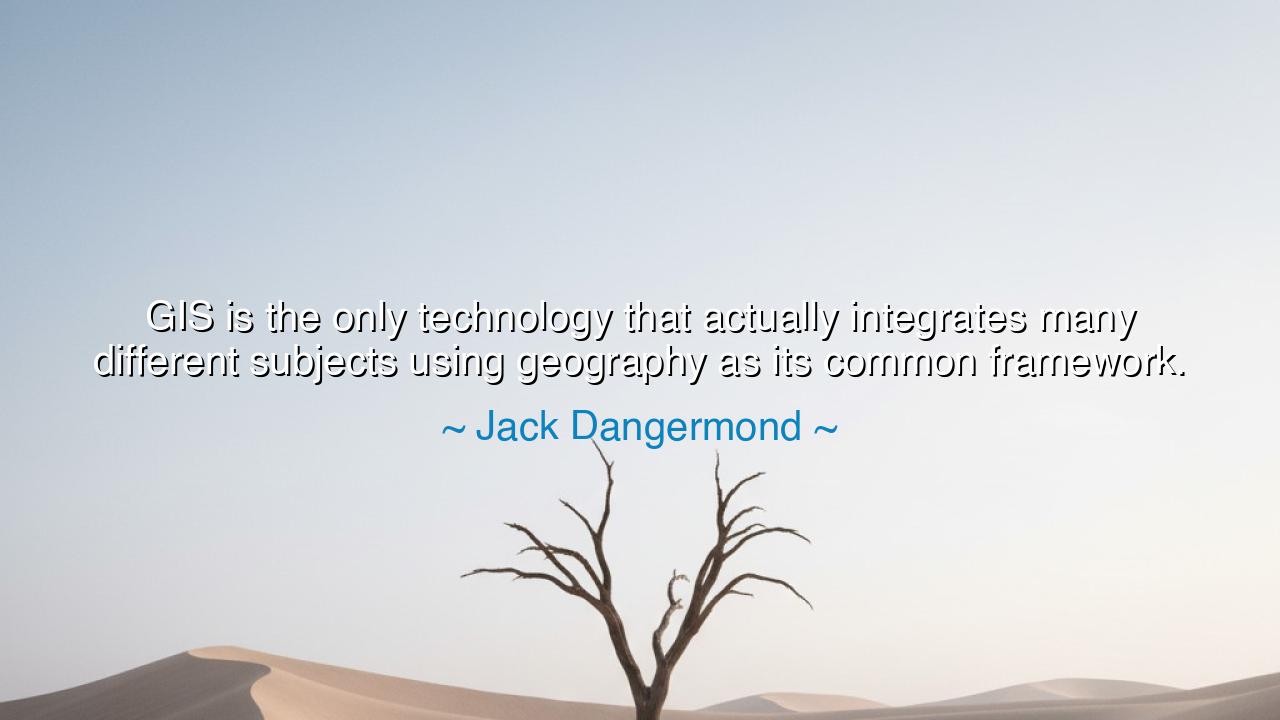
GIS is the only technology that actually integrates many
GIS is the only technology that actually integrates many different subjects using geography as its common framework.






The words of Jack Dangermond, pioneer of digital mapping and founder of Esri, resound with timeless weight: “GIS is the only technology that actually integrates many different subjects using geography as its common framework.” In this declaration, he reveals a truth that transcends mere science — that geography is the silent web that binds all things, and that GIS — Geographic Information Systems — is the tool by which modern man can unveil this hidden unity. Where once maps were drawn by hand, limited to borders and rivers, now arises a technology that draws together the disciplines of earth, life, and society into one great tapestry.
Consider the ancients, who knew instinctively that the land was the stage upon which all human drama unfolded. The Nile was not merely a river; it was the spine of Egyptian civilization, linking agriculture, religion, and commerce in one living framework. Yet the Egyptians did not have GIS; they had wisdom and observation. Dangermond’s words proclaim that now, through the power of modern invention, we can integrate countless fields — economics, biology, climate, politics, urban design — all through the lens of geography, which holds them together like the threads of destiny woven on a single loom.
A striking example lies in the battle against disease. In the 19th century, physician John Snow mapped the cholera outbreak in London, tracing the epidemic to a contaminated water pump on Broad Street. Though he had no computers, his work was an early act of GIS thinking: connecting health, infrastructure, and geography into one picture. Today, GIS magnifies this power a thousandfold, enabling nations to track the spread of pandemics, understand the influence of climate on illness, and direct aid where it is needed most. This is the heroic power Dangermond speaks of: the integration of knowledge through place.
But GIS is not confined to health alone. It shapes cities, guiding planners in weaving together roads, schools, energy, and housing with foresight rather than chaos. It aids farmers, revealing where the soil is rich and where the rains will bless or curse. It informs conservationists, showing how forests, rivers, and wildlife connect in delicate balance. It empowers governments, revealing where poverty concentrates, where resources lie hidden, and where danger may rise. In all these, geography becomes the common framework, the eternal stage upon which human action must unfold.
Dangermond’s statement is born from his life’s mission, for he saw that as data multiplied in the modern world, it often stood fragmented and divided. Economists, scientists, ecologists, and engineers each worked in their own silos. But the earth itself knows no silos; it is one great whole. GIS stands as the bridge, bringing unity to diversity, showing that all things — human and natural, physical and digital — are bound together by place. This insight, though forged by computers, echoes the ancient wisdom of the Greeks, who declared: “Know thy place, and thou shalt know thyself.”
The lesson here is clear: do not seek knowledge in fragments, but in wholeness. Whether one studies technology, society, or nature, the wisest path is to see how they converge in the living world around us. GIS teaches us that integration is the key to wisdom — that to solve the challenges of our age, we must weave together insights, not scatter them. The desert cannot be understood apart from the river, nor the city apart from its fields, nor the human apart from the earth upon which he treads.
Therefore, O children of the future, remember the teaching of Jack Dangermond. Let your studies, your inventions, your policies, and your dreams be bound by the framework of geography, for it is the stage that unites all disciplines and all destinies. Embrace tools like GIS, not as mere machines, but as instruments of harmony, allowing humanity to see the whole truth and not merely its fragments. For only by integrating knowledge through place can we hope to build a future that is both wise and enduring.






AAdministratorAdministrator
Welcome, honored guests. Please leave a comment, we will respond soon